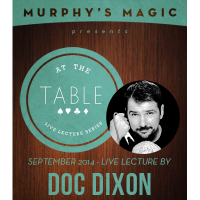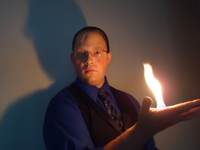At the Table Live Lecture - Doc Dixon 9/17/2014 - video DOWNLOAD
Dixon, Doc
Murphy's Magic Supplies, Inc.
(Based on 2 reviews)

In this lecture, Doc is going to keep you laughing while sharing with you some of the secrets that has made him so successful over the years. Prepare to be entertained with Doc Dixon!
This is what Doc's lecture will cover:
T.O.D.P.:
A "prequel" to perform before tossed out deck
Five hands Plus One:
A pseudo double duke riffle stack from a shuffled deck. Combines the ideas of Marlo, Leipzig, Gardner and yours truly.
Pull my finger:
A spectator pulls off the performer's index finger. Like "The Web", but without the arachnophobia baggage.
Carpe Cajones Revisited:
A performer writes a prediction on the face of a playing card, predicting the selected card and the month the spectator was born. Introduces the "Carpe Cajones" concept, a power concept for predictions.
Bits of Business:
Small, yet powerful additions to classic tricks, including the McCombical Prediction and a VERY commercial use for a chick pan for restaurant workers.
All this PLUS 3-5 more effects, all fresh from the mind of Doc Dixon!
Reviews
(Top ▲)
Doc Dixon is talented when it comes to handling a deck of cards and is fairly funny as well. In this lecture one of the best parts was how well he and Mike Hankins played off each other. Let’s get into it.
Pull My Finger: This trick is broken down into two pieces, one made specifically for magicians and the other made specifically for laypeople.
In the first effect he has his finger signed, makes it vanish and appear in a box that has been in full view the whole time. This was a trick for magicians, it was just funny. There wasn’t any special method or selling point, in fact it wasn’t even explained. It was just full of magician, in jokes.
In the second trick the spectator is made to catch the magicians finger and to their surprise they pop it right off. This is a fun opener and probably would play really well if it was performed by the right guy. Dixon relates the feeling to the spider on the hand effect except that it is a little less terrifying and a bit more fun.
Name a Card Gag: I really liked this, it is his idea for a think a card trick. I think I may use this in the future, although I’m not sure what kind of venue would be best. I can’t give much away here but I can say that it involves exposing a trick deck that magicians rarely use in serious situations.
Prequel to the Tossed Out Deck: This is his take on David Williamson’s classic 52 Cards to Pocket. After performing some classic bits with a selected card and it being propelled from the deck the deck ends up in his pocket with only the selected card left in his hand. This is fairly classic but he has added a nice bit that allows you to very cleanly ring in a cooler.
Gambling: This is a fun little gambling demonstration where you deal the spectator the winning hand and then show that in fact you have the winning hand. The deck is shuffled before and there are various clever pieces of business that give the idea that the spectator has the control. This is nice, there is a lot to remember and it requires you to secretly perform a few false deals.
Copier Card: A card is selected and it apears in various parts of the deck. It is found on top and placed aside, it is found on bottom and placed aside, it is found in the middle and placed aside. The cards that were placed aside are changed into the aces and the selected card ends up in the magicians mouth. To warm up to the trick he uses the aces in Dr. Daley’s last Trick as well as some effects from Erdnase. He breezes through the explanations for these effects, as they are available in many other places besides this lecture.
Bits of Buisness: Here he runs through some rapid fire ideas on coffee containers, prop management, torn and restored newspaper, misers dream and so on. There are a few things here that some may like but not everything is for everyone.
Comedy Magic Q and A: Dixon has worked many venues as a comedy magician. He shares the ins and outs of his scripting process as well as the type of material he uses and how to handle hecklers. There’s some good information here.
Carpe Cajones: A card is selected and month is named, both of which were predicted on a playing card by the magician at the outset of the trick. This is a strong effect, I’m unsure on some of the points on the handling but I do like the main effect. You will need to learn some tough sleights and gimmick up a deck of cards but you are left with a strong trick.
Memory Drill: 4 cards are shown and memorized, they then change into the 4 aces. You learn a neat move here called the Dixon drop and it is could be used in many scenarios. You do need a table, as you may with many of the other effects mentioned above.
So that’s the lecture. I found it to be entertaining enough. I would have liked to see more original magic that would be suitable for a comedy club as it seemed that that was the subject of the majority of the lecture. There were some good things discussed here though.
Pull My Finger: This trick is broken down into two pieces, one made specifically for magicians and the other made specifically for laypeople.
In the first effect he has his finger signed, makes it vanish and appear in a box that has been in full view the whole time. This was a trick for magicians, it was just funny. There wasn’t any special method or selling point, in fact it wasn’t even explained. It was just full of magician, in jokes.
In the second trick the spectator is made to catch the magicians finger and to their surprise they pop it right off. This is a fun opener and probably would play really well if it was performed by the right guy. Dixon relates the feeling to the spider on the hand effect except that it is a little less terrifying and a bit more fun.
Name a Card Gag: I really liked this, it is his idea for a think a card trick. I think I may use this in the future, although I’m not sure what kind of venue would be best. I can’t give much away here but I can say that it involves exposing a trick deck that magicians rarely use in serious situations.
Prequel to the Tossed Out Deck: This is his take on David Williamson’s classic 52 Cards to Pocket. After performing some classic bits with a selected card and it being propelled from the deck the deck ends up in his pocket with only the selected card left in his hand. This is fairly classic but he has added a nice bit that allows you to very cleanly ring in a cooler.
Gambling: This is a fun little gambling demonstration where you deal the spectator the winning hand and then show that in fact you have the winning hand. The deck is shuffled before and there are various clever pieces of business that give the idea that the spectator has the control. This is nice, there is a lot to remember and it requires you to secretly perform a few false deals.
Copier Card: A card is selected and it apears in various parts of the deck. It is found on top and placed aside, it is found on bottom and placed aside, it is found in the middle and placed aside. The cards that were placed aside are changed into the aces and the selected card ends up in the magicians mouth. To warm up to the trick he uses the aces in Dr. Daley’s last Trick as well as some effects from Erdnase. He breezes through the explanations for these effects, as they are available in many other places besides this lecture.
Bits of Buisness: Here he runs through some rapid fire ideas on coffee containers, prop management, torn and restored newspaper, misers dream and so on. There are a few things here that some may like but not everything is for everyone.
Comedy Magic Q and A: Dixon has worked many venues as a comedy magician. He shares the ins and outs of his scripting process as well as the type of material he uses and how to handle hecklers. There’s some good information here.
Carpe Cajones: A card is selected and month is named, both of which were predicted on a playing card by the magician at the outset of the trick. This is a strong effect, I’m unsure on some of the points on the handling but I do like the main effect. You will need to learn some tough sleights and gimmick up a deck of cards but you are left with a strong trick.
Memory Drill: 4 cards are shown and memorized, they then change into the 4 aces. You learn a neat move here called the Dixon drop and it is could be used in many scenarios. You do need a table, as you may with many of the other effects mentioned above.
So that’s the lecture. I found it to be entertaining enough. I would have liked to see more original magic that would be suitable for a comedy club as it seemed that that was the subject of the majority of the lecture. There were some good things discussed here though.
(Top ▲)
Doc does not give lectures often and does not particularly perform a lot of public shows like many working professionals. Rather, he concentrates on the private and corporate sectors.
In watching this lecture you will see that he has put a lot of time into research, practice and rehearsal - he has a very smooth flow to everything he does. This also leads me to something else that I really appreciate and something you may or may not notice when watching him: He tends to perform a lot of the classic effects in magic.
What I mean by that is while he adds his own personal touch and a certain amount of finesse to them, almost everything he does is or is based on a classic magic effect/routine/plot. The classics are just that for a reason - they work and they have stood the test of time.
In this lecture, Doc teaches quite a few effects and I would say that most of them will take some amount of practice to make them smooth, but there is nothing particularly difficult. Except the pass - which he teaches very well - but it is still difficult.
There are some very good gags shown and most are explained. The few that are not explained are either known by most magicians or you can figure it out just by watching it - they are just what they appear to be: verbal/sight gags.
There is a little bit of everything in this lecture and I think just about everyone will get something out of this - even the "young and hip" XCM guys, even though there is no XCM in this lecture.
In watching this lecture you will see that he has put a lot of time into research, practice and rehearsal - he has a very smooth flow to everything he does. This also leads me to something else that I really appreciate and something you may or may not notice when watching him: He tends to perform a lot of the classic effects in magic.
What I mean by that is while he adds his own personal touch and a certain amount of finesse to them, almost everything he does is or is based on a classic magic effect/routine/plot. The classics are just that for a reason - they work and they have stood the test of time.
In this lecture, Doc teaches quite a few effects and I would say that most of them will take some amount of practice to make them smooth, but there is nothing particularly difficult. Except the pass - which he teaches very well - but it is still difficult.
There are some very good gags shown and most are explained. The few that are not explained are either known by most magicians or you can figure it out just by watching it - they are just what they appear to be: verbal/sight gags.
There is a little bit of everything in this lecture and I think just about everyone will get something out of this - even the "young and hip" XCM guys, even though there is no XCM in this lecture.










